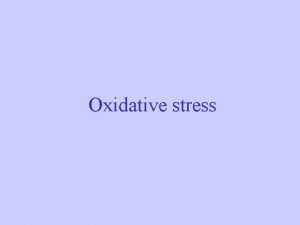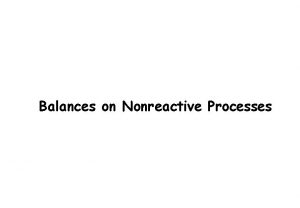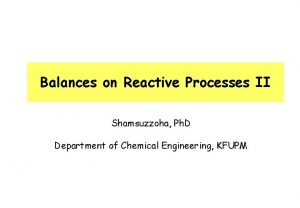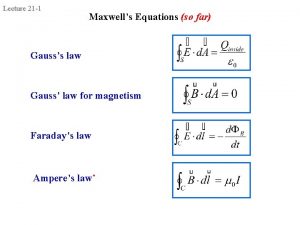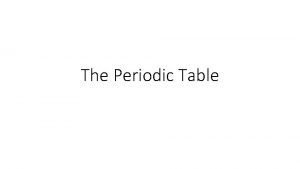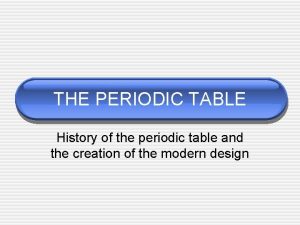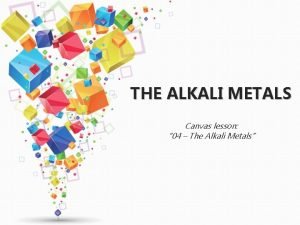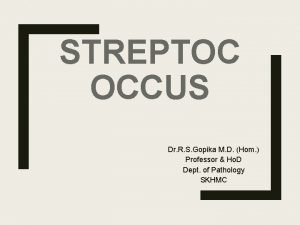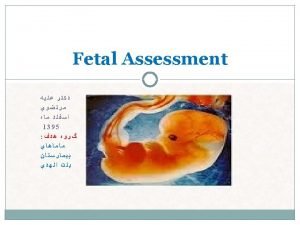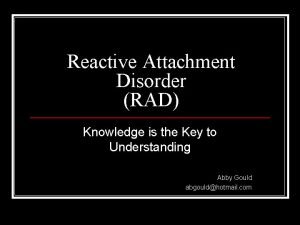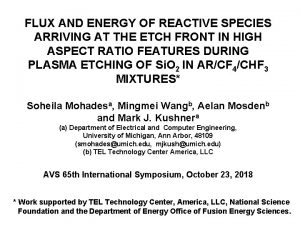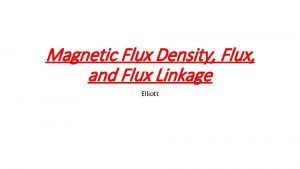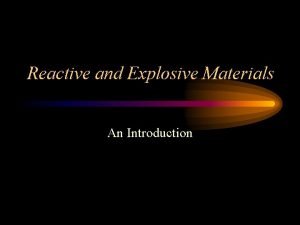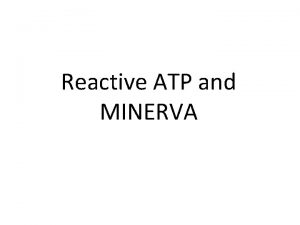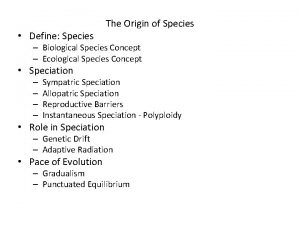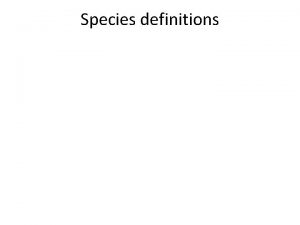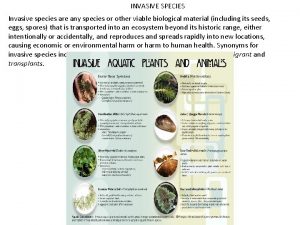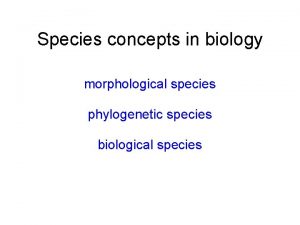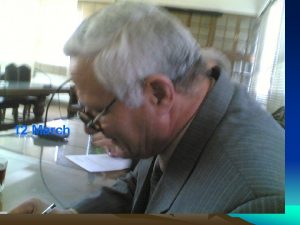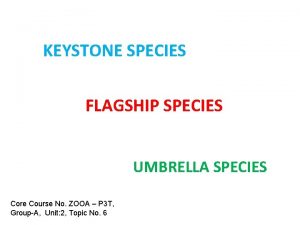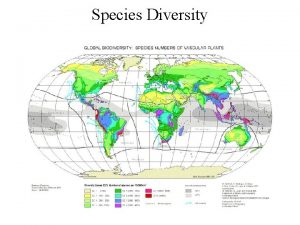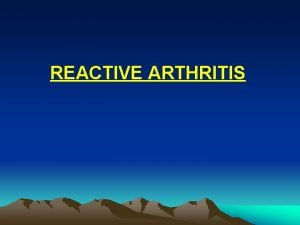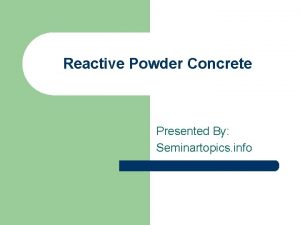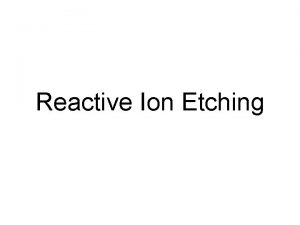FLUX AND ENERGY OF REACTIVE SPECIES ARRIVING AT
















![PLASMA PROPERTIES WITH PULSING [e]: max=5× 1010 cm-3 MIN MAX PULSE BC = 1 PLASMA PROPERTIES WITH PULSING [e]: max=5× 1010 cm-3 MIN MAX PULSE BC = 1](https://slidetodoc.com/presentation_image_h/9d3250b6da304782858230378f86e463/image-17.jpg)







- Slides: 24

FLUX AND ENERGY OF REACTIVE SPECIES ARRIVING AT THE ETCH FRONT IN HIGH ASPECT RATIO FEATURES DURING PLASMA ETCHING OF Si. O 2 IN AR/CF 4/CHF 3 MIXTURES* Soheila Mohadesa, Mingmei Wangb, Aelan Mosdenb and Mark J. Kushnera (a) Department of Electrical and Computer Engineering, University of Michigan, Ann Arbor, 48109 (smohades@umich. edu, mjkush@umich. edu) (b) TEL Technology Center America, LLC AVS 65 th International Symposium, October 23, 2018 * Work supported by TEL Technology Center, America, LLC, National Science Foundation and the Department of Energy Office of Fusion Energy Sciences.

AGENDA Control for HAR etching. Description of the models Dual-frequency Ar/CF 4/CHF 3 plasma: characterization of reactive fluxes and ion energy and angular distributions (IEADs) vs. LF Power LF Frequency Pulsed Dual Frequency CCP Ion and neutral fluxes and energy in etching profiles for continuous wave (CW) and pulsed power Concluding Remarks AVS_2018 University of Michigan Institute for Plasma Science & Engr.

DUAL FREQUENCY CCP SOURCES Dual frequency capacitively coupled plasmas (DF-CCPs) are widely used for etching and deposition in the microelectronics industry. DF-CCP are used to better control the ion and radical fluxes with the higher frequency (HF) and the shape of IED with the lower frequency (LF). Pulsed power is one technique to provide additional means to control IED. Ion energy distribution (IED) is an important factor in high aspect ratio (HAR) etching. This computational investigation addresses plasma dynamics and control of IEADs onto wafers for improving CD control of Si. O 2 HAR etching. AVS_2018 • Itsuko Sakai et al 2018 Jpn. J. Appl. Phys. 57 098004 University of Michigan Institute for Plasma Science & Engr.

HYBRID PLASMA EQUIPMENT MODEL (HPEM) Plasma Chemistry Monte Carlo Simulation Monte Carlo Feature Profile Model Surface Chemistry Modules used for this research: Electron Monte Carlo Simulation Fluid-Kinetics Poisson's Equation Plasma Chemistry Monte Carlo Simulation Monte Carlo Feature Profile Model AVS_2018 University of Michigan Institute for Plasma Science & Engr.

MONTE CARLO FEATURE PROFILE MODEL Profile is defined on a 2 D mesh, with cells representing a material. Gas phase pseudo-particles are launched with fluxes, energy and angular distributions derived from Hybrid Plasma Equipment Model (HPEM). Trajectories of particles are tracked until striking solid. Surface reaction mechanism defines outcome of collisions. Chemical reaction (material change) Etching (removing cells) Deposition (adding cells) Implantation and mixing Charging addressed through solution of Poisson's equation. AVS_2018 University of Michigan Institute for Plasma Science & Engr.

REACTOR GEOMETERY Quartz Nozzle, Metal Wall Wafer Silicon Biased Substrate Quartz Pressure Sensor Pump Dual-frequency capacitively coupled plasma (CCP) with both frequencies on bottom electrode. 2 D, cylindrically symmetric, gap=3. 5 cm Base conditions: Ar/CF 4/CHF 3 = 5/75/20, 500 sccm, 15 m. Torr. HF: 40 MHz, 500 W; LF: 10 MHz, 100 W. Phases are locked. The voltage is specified for each frequency and applied to bottom substrate: ~ 263 / 170 V, Vdc-block=-235 V, Vdc-sub=0 V. AVS_2018 University of Michigan Institute for Plasma Science & Engr.

PLASMA REACTION MECHANISM – CF 4/CHF 3/Ar Ar/CF 4/CHF 3 = 5/75/20, 500 sccm, 15 m. Torr Species in gas phase reaction mechanism: CF 4, CF 3, CF 2, CF, C, F, F 2, C 2 F 4, C 2 F 6, CF 3+, CF 2+, CF+, C+, F+, CF 3 -, F-, CHF 3, CHF 2+, H, HF, H+, Ar, Ar(4 s-metastable), Ar (4 s-radiative), Ar(4 p), Ar+, AVS_2018 University of Michigan Institute for Plasma Science & Engr.

Si. O 2 POLYMER MEDIATED ETCHING Si. O 2 etching in fluorocarbon plasmas occurs through polymer layer. Ions energy is delivered to the surface by implantation through the polymer: chemical sputtering, physical sputtering mixing interface. Radicals react with polymer and with surface after diffusing through the polymer. Ion activation of Si. O 2 Cx. Fy complex removes O as COFx. F diffusion through polymer removes Si as Si. Fx. O consumes CFx polymer to mediate thickness. F atom etching of polymer during diffusion. Mechanism modified for CHF 3 derived H-containing species. AVS_2018 University of Michigan Institute for Plasma Science & Engr.

PLASMA PROPERTIES: BASE CASE Majority of power deposition that produces ions comes from HF. LF power deposition is primarily ion acceleration in the sheath. With large HF power, bulk ionization (Se) is dominant. Ions distributed uniformly above the wafer. Edge peaked of electron due to electrostatic edge effect. Ar/CF 4/CHF 3 = 5/75/20, 15 m. Torr, 500 sccm, 40/10 MHz = 0. 5/0. 1 k. W AVS_2018 Se: 3. 7× 1015 cm-3, 3 dec [e]: max=2. 6× 1010 cm-3, 2 dec 4. 6 Te: max=11. 5 ev [M+]: 1. 2× 1011, 2 dec University of Michigan Institute for Plasma Science & Engr.

Radical Flux (cm-2 s-1) CF 2 C 2 F 4 F CF 3 CF C 2 F 6 CHF 2 Ion Energy Distribution (e. V-1) RADICAL, ION FLUXES TO WAFER: BASE CHF 2+ CF 3+ Ar+ CF 2+ CF+ F+ Energy (e. V) Ion Flux (cm-2 s-1) CF 3+ CHF 2+ AVS_2018 CF+ Ar+ Radius (cm) CF 2+ With significant dissociation, radical fluxes dominated by CFx and F. Reactive radical fluxes exceed ion fluxes by 1 -2 orders of magnitudes. Ion fluxes dominated by CF 3+ due to larger mole fraction of CF 4. University of Michigan Institute for Plasma Science & Engr.

Ion Flux (cm-2 s-1) CF 3 + Ar + CF + CHF 2+ C+ Power (W) CF 2 + Radical Flux (cm-2 s-1) ION AND RADICAL FLUXES TO WAFER: LF POWER F H CF 2 CF C 2 F 4 CF 3 HF C 2 F 6 CHF 2 Power (W) LF Power: 10, 100, 500 W; 1, 5, 10, and 20 k. W. Fluxes to the wafer collected at radius of 6 cm. Ion sources dominated by HF and so weaker dependence of ion fluxes on LF power up to 1 k. W. Transition of LF to radical generation mode occurs at a few k. W when power significantly exceeds that of HF. Significant increase in C+ due to additional fragmentation. AVS_2018 University of Michigan Institute for Plasma Science & Engr.

LF POWER: IEADs 100 W 500 W 1000 W -605 V -945 V 5 k. W 10 k. W 20 k. W -1. 9 k. V -2. 6 k. V -3. 5 k. V Energy (ev) Dc Bias -235 V Angle (deg) HF/LF = 263/170 V, 605/317 V, 340/1008 V 0. 38/2. 4 k. V 0. 42/3. 36 k. V 0. 46/4. 49 k. V Total ions, 2 -dec Increasing LF power has little effect on [e] since electron heating scales with ω2. Majority of additional power results in ion acceleration. Increased ion energies and narrower IADs with increasing LF power. High ion energies required for etching of HAR features. Narrow ion angular distributions reduce sidewall impacts. Ar/CF 4/CHF 3 = 5/75/20, 15 m. Torr, 500 sccm, 40/10 MHz = 500 W / 0. 1 − 20 k. W AVS_2018 MIN MAX University of Michigan Institute for Plasma Science & Engr.

Ion Energy Distribution (e. V-1) LF POWER, IED Energy (e. V) Ar/CF 4/CHF 3 = 5/75/20, 15 m. Torr, 500 sccm, 40/10 MHz = 0. 5/0. 1 − 20 k. W AVS_2018 Total IED. Ion energy increases by increasing LF power while energy distribution broadens. The LF power is mainly deposited into the sheath – the width of IED increases with LF power. During the negative polarity of LF cycle, increase in sheath potential accelerates ions to higher energy. During positive polarity of LF cycle, sheath potential is dominated by HF which is unchanged. University of Michigan Institute for Plasma Science & Engr.

LF FREQUENCY: IEAD 1 MHz 2 MHz 5 MHz 10 MHz 20 MHz Energy (ev) Ar/CF 4/CHF 3 = 5/75/20, 15 m. Torr, 500 sccm, 40/1− 20 MHz = 0. 5/0. 1 k. W Total ions, IEADs, 2 -dec Vdc-block -197 V MIN -175 V -238 V -235 V MAX -167 V Angle (deg) HF/LF= 262/211 V 267/206 V 275/200 V 263/170 V 244/175 V IEAD is broadened by decreasing LF frequency and is shifted to higher energies. Self DC-bias (most negative at 5 MHz) changes with LF frequency to compensate for change in displacement current and balance the conduction. Narrow ion angular distribution (< ± 4 deg) results in more “anisotropic” etch profile. AVS_2018 University of Michigan Institute for Plasma Science & Engr.

Ion Energy Distribution (e. V-1) LF FREQUENCY: IED Energy (e. V) Ion and radical fluxes are nearly independent of LF frequency and so negligible change in conduction current. Ar/CF 4/CHF 3 = 5/75/20, 15 m. Torr, 500 sccm, AVS_2018 40/10 MHz = 0. 5/0. 1 k. W Increased number of peaks by decreasing LF frequency: single peak to bimodal. With longer LF cycle, sheath is then modulated by HF, with the LF sheath appearing to be “DC”. At higher LF, ion transit time across the sheath is sufficiently longer than the RF cycle reflects a time averaged sheath characteristic. University of Michigan Institute for Plasma Science & Engr.

PULSED POWER Use of pulse power provides a means for controlling IED, and so control etch properties. Pulsing enables both plasma potential and dc-bias to change beyond the steady state values in CW operation. Simultaneous pulsing both LF and HF Duty-cycle = 50%, PRF = 10 k. Hz, 3 pulses Constant power= 500 W (HF, 40 MHz), 100 W (LF, 10 MHz) AVS_2018 University of Michigan Institute for Plasma Science & Engr.
![PLASMA PROPERTIES WITH PULSING e max5 1010 cm3 MIN MAX PULSE BC 1 PLASMA PROPERTIES WITH PULSING [e]: max=5× 1010 cm-3 MIN MAX PULSE BC = 1](https://slidetodoc.com/presentation_image_h/9d3250b6da304782858230378f86e463/image-17.jpg)
PLASMA PROPERTIES WITH PULSING [e]: max=5× 1010 cm-3 MIN MAX PULSE BC = 1 n. F ne and Vdc-block increase with pulse rising time due to small blocking capacitance (BC), and drop to CW values at the fall time of pulse. Total ion fluxes collected at the center of wafer increase following the ionization source and then decrease after pulse is off. AVS_2018 Animation Slide University of Michigan Institute for Plasma Science & Engr.

IEAD EVOLUTION THROUGH A CYCLE Time (μs) 32 128 248 488 512 536 632 776 800 1000 Energy (ev) CW Angle (deg) Each cycle=1000 μs, 50% duty cycle IEAD averaged every 3 iterations over the last pulse. IEAD is highest at the beginning of the pulse following changes in Vdc-block, decreases to the lowest energy after power is off then increases slightly due to negative Vdc-block. Not a noticeable change on IAD with pulsing both LF and HF. AVS_2018 MIN MAX University of Michigan Institute for Plasma Science & Engr.

HAR ETCH PROFILE, CW LF power = 1 k. W 500 5 100 PR Etch rate increases with LF power increase due to higher ion energy. Low ion energies in base case leads to broad angular distributions and undercutting. Height (μm) 4 40/10 MHz = 0. 5/ 0. 1 -1 k. W Critical Dimension (CD)= 54 nm AR=100 3 Si. O 2 2 1 Si 160 nm Animation Slide University of Michigan Institute for Plasma Science & Engr.

ETCH PROFILE WITH PULSED POWER Pulsed 5 CW, 100 W PR Height (μm) 4 160 nm 3 Si. O 2 2 1 Si 160 nm AVS_2018 Pulsed PR: Hard mask Critical Dimension (CD)= 54 nm Aspect Ratio (AR)= 100 Pulsing CCP can resemble Bosch process: The pulse off cycle is the passivation step where a polymer layer is deposited isotropically on the etch front and sidewall. During pulse-on cycle, the passivation polymer layer at the etch front is removed while the sidewall passivation remains intact due to the directionality of plasma bombardment. In this case, pulsing produces more tapered profile. University of Michigan Animation Slide Institute for Plasma Science & Engr.

Fluxes to etch front (cm-2 s-1) ION AND NEUTRAL FLUXES vs. AR Aspect Ratio Flux and energy of ions, hot and thermal neutrals to the etch front. As ions strike sidewall converted to hot neutrals. Energy is “first hit. Thermal neutrals originate from: Thermal fluxes from the plasma entering the feature. Slowing hot neutrals. AVS_2018 Decrease in ion fluxes with AR due to decreasing viewangle to plasma. Higher thermal neutral flux at high AR is due slowing hot neutrals and low conduction to leave feature. If it is difficult to get into the feature, it is difficult to get out of the feature. University of Michigan Institute for Plasma Science & Engr.

Hot Neutrals Aspect Ratio Energy (ev) Fluxes to etch front (cm-2 s-1) ION AND HOT NEUTRAL FLUXES vs. AR Aspect Ratio AVS_2018 Record of ion energy is “first hit” after which particle is hot neutral. Decrease in hot neutral flux with AR due to energy loss scattering but are less sensitive to view-angle than ions. Flux of all hot neutrals decrease with AR – an ARDE effect. Ions energy drops with AR due to smaller view-angle. Energy continues as “hot neutral” with a smaller dependence on AR. University of Michigan Institute for Plasma Science & Engr.

Energy to etch front (ev) ION ENERGY vs. HAR AND IEAD Energy (ev) Aspect Ratio AVS_2018 Angle (deg) Trend in ion energy with AR varies for different ions. CF 3+ and Ar+ energy reaching the etch front are less sensitive to HAR while CF+ energy drops significantly. In this case, the difference in ions energy trend can depends on IEAD: Narrow view-angle at large AR affects IEADs differently having different angular distributions. CF 3+ has narrower angular distribution than CF+, and so less sensitive to AR. University of Michigan Institute for Plasma Science & Engr.

CONCLUDING REMARKS DF-CCP sustained in Ar/CF 4/CHF 3 with HF /LF =40/10 MHz and IEAD and fluxes parameterized by changing LF power and frequency. Increasing LF power increases ions fluxes to wafer due to ion acceleration and large self-DC bias voltage. Broadened IEAD with decreasing LF frequency. Higher LF power: higher energy, broader IEDs and narrower IADs due to power deposition into sheath, therefore higher etch rate − narrow IAD and high ion energy are important for HAR etching. Pulsed power provide additional control on plasma by increasing ion energy and fluxes during pulse on period, compared to CW. Ion and hot neutral fluxes drop with AR while thermal neutral flux maintain its flux deep in the feature due low conductivity. Ion energy decreases with AR due to narrower view-point. It is observed that the shape of IEAD for each ion affect its energy drop with AR: CF 3+ energy does not decrease with AR. AVS_2018 University of Michigan Institute for Plasma Science & Engr.
 Departure procedure in hotel
Departure procedure in hotel Difference between antiferromagnetism and ferrimagnetism
Difference between antiferromagnetism and ferrimagnetism Magnetic field density
Magnetic field density Reactive oxygen species examples
Reactive oxygen species examples A keystone
A keystone Hypothetical process path
Hypothetical process path C4h12
C4h12 Energy energy transfer and general energy analysis
Energy energy transfer and general energy analysis Energy energy transfer and general energy analysis
Energy energy transfer and general energy analysis Energy flux
Energy flux Active power reactive power apparent power
Active power reactive power apparent power Inactivism planning
Inactivism planning Pupils equal and reactive to light
Pupils equal and reactive to light It is an active process of discovery
It is an active process of discovery Reactive change is change that
Reactive change is change that Strategic sourcing process flow
Strategic sourcing process flow Reactive hyperemia
Reactive hyperemia Reactivity in periodic table
Reactivity in periodic table Where is the most reactive elements on the periodic table
Where is the most reactive elements on the periodic table Are alkali metals reactive
Are alkali metals reactive Poststreptococcal reactive arthritis
Poststreptococcal reactive arthritis Reactive anger
Reactive anger Reactive nst
Reactive nst Rad psychology definition
Rad psychology definition Reactive attachment disorder
Reactive attachment disorder



